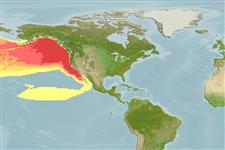Common names from other countries
Classification / Names / Names
Common names | Synonyms | Catalog of Fishes (gen., sp.) | ITIS | CoL | WoRMS
Environment: milieu / climate zone / depth range / distribution range
Ecology
Pelagic-neritic; depth range 0 - 1580 m (Ref. 1394). Subtropical; 90°N - 10°N, 180°W - 180°E
Eastern Pacific.
Length at first maturity / Size / Weight / Age
Maturity: Lm ? range ? - ? cm Max length : 500 cm TL male/unsexed; (Ref. 1394); 300 cm TL (female); max. published weight: 2.2 t (Ref. 1394); max. published weight: 2.2 t
Feeds on squids, small sharks, and deep water fishes (Ref. 1394). Feeds on squids, small sharks, and deep water fishes (Ref. 1394). When hunting, this mammal plunges to depths of 300 to 800 meters and shuts down blood flow to critical organs resulting to excessive blood levels of carbon monoxide (Ref. 95857).
Jefferson, T.A., S. Leatherwood and M.A. Webber. 1993. (Ref. 1394)
IUCN Red List Status (Ref. 130435)
CITES status (Ref. 108899)
Not Evaluated
Not Evaluated
Human uses
Fisheries: commercial
FAO - Fisheries: species profile | FishSource | Sea Around Us
Tools
Internet sources
Estimates based on models
Preferred temperature
(Ref.
115969): 1.5 - 5.3, mean 1.6 (based on 670 cells).
Vulnerability
Very high vulnerability (90 of 100).
Price category
Unknown.
